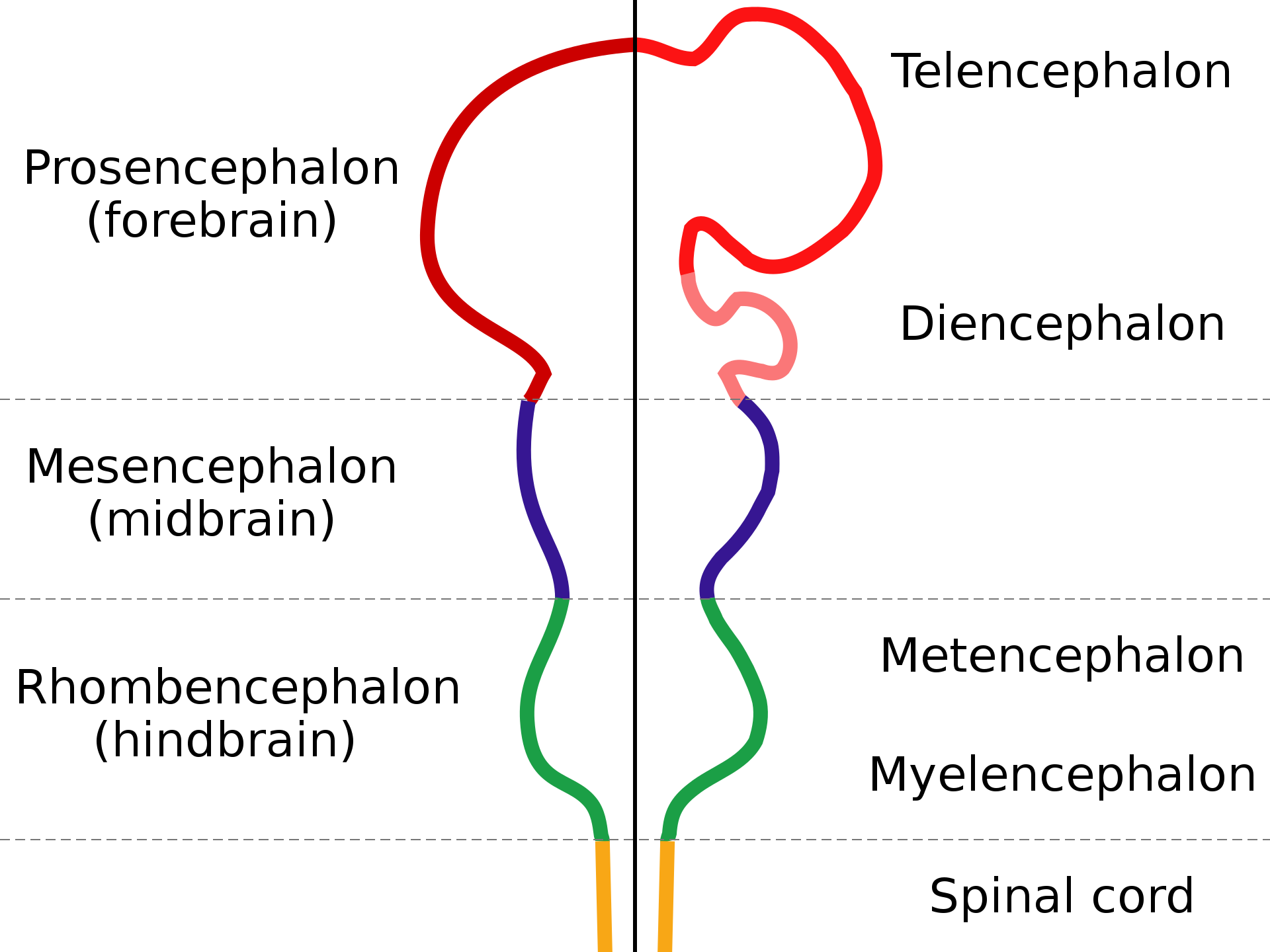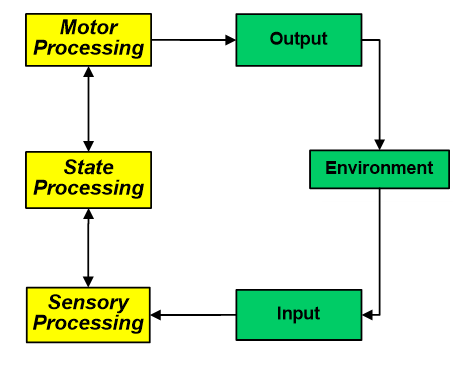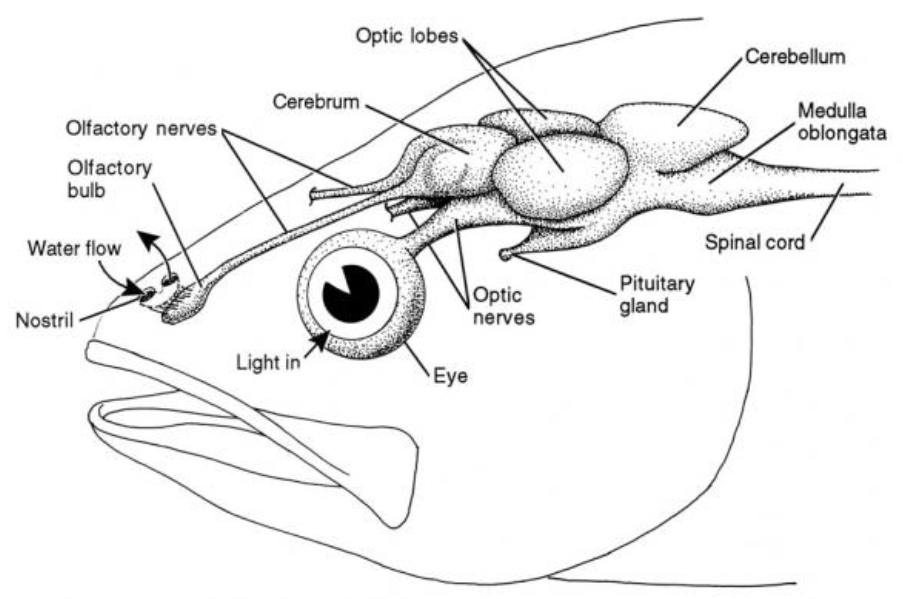
The human brain grows from a neural tube, whose forebrain, midbrain and hindbrain areas later form the cortex, limbic and cerebellum systems (Figure 6.24). This basic division reflects three basic brain functions:
1. Input. What is out there?
2. State. What is the body state?
3. Output. What actions can be done?
Life involves all three, as animals must sense food or danger, know if the body is hungry or tired, and control actions like biting to survive. The neural tube then evolved to analyze input patterns, evaluate body state and control muscle schema, and this evolution occurred in parallel not in sequence.

An engineer might design a feedback system to analyze input, assess internal state and direct responses in that order, then integrate them (Figure 6.25), but evolution didn’t do that. Given three necessary functions, it developed them all at once in different ways because the brain has no control center.
Three-center theory is that the hindbrain, midbrain, and forebrain evolved as independent feedback control centers for:
1. Sensory control: Based on sensory patterns.
2. State control: Based on body state feelings.
3. Movement control: Based on muscle schema.
How an animal responds depends on which control center drives the feedback loop at a given moment, as an animal with a chance to bite might do so under movement control, freeze in place from fear under state control, or decide that the threat isn’t really dangerous and ignore it under sensory control.
The brain evolved motor processing first, perhaps because action is critical to survival. Single-celled life moved before it saw, and embryo motor nerves develop before sensory ones, so babies kick in the womb before their eyes even start working.

Fish brains have forebrain optical and olfactory areas to process sense data, a midbrain amygdala and pituitary to manage endocrine tasks, and a hindbrain to handle movement (Figure 6.26). All three functions exist, but the cerebellum of fish is far more evolved than its cortex (Montgomery et al., 2012), so it probably controlled the feedback loop using data from the primitive forebrain and midbrain.
In fish, the forebrain area that receives muscle data is next to the area that directs movement, as it is for us, perhaps because it is easier to use the same paths for both, and having sensory and motor areas close to each other improves sensorimotor timing. For us, the motor cortex directs movement but for fish, it is probable that the cerebellum controls the motor cortex, as it projects both excitatory and inhibitory nerves to it (Daskalakis et al., 2004).

In humans, the hindbrain bulges out from the base of brain as the cerebellum (Figure 6.27). It may be ancient but the cerebellum has more neurons than the rest of the brain put together! Its two cross-linked hemispheres are known to control complex movement and it was certainly the most advanced part of the brain when reptiles ruled the earth. If the hindbrain was the first brain control center to evolve, can it still control the body using primitive links to the early forebrain and midbrain?
In infant swimming, babies instinctively hold their breath underwater thanks to a diving reflex and move their arms and legs in parallel to propel them through the water by an amphibian reflex that flexes same-side hip and knee kicks. These instinctive actions disappear later, as the child learns to swim as people do, by moving limbs alternately. That babies swim as reptiles do but lose the ability after four months suggests that the brain retraces its reptilian ancestry as it matures.
In parasomnia, sleepwalkers can get up, walk, eat, cook dinner or ride a motorbike while asleep and wake up later with no recall. With the cortex and midbrain dormant, the hindbrain moves the body by itself and there is no recall because the midbrain isn’t laying down memories. Sleepwalking behavior isn’t just reflexes, as cooking a meal is a purposeful act that requires constant situational adaptation. It follows that the hindbrain can control the body entirely, like a brain in itself, without the cortical intellect or episodic memory.
Hindbrain control also explains blindsight, where people with visual cortex damage report seeing nothing but can still catch a ball or insert an object into a tilted slot whose orientation they say they can’t see (Goodale & Milner, 2004). When cortical systems that identify objects fail, the hindbrain can use older subcortical paths to handle spatial location and direct motor acts by implicit perception (Hannula et al., 2005). Primitive circuitry that evolved when the cortex was still in its infancy is used to direct motor output.
When later systems fail, older ones take their place, so aphasic subjects who can’t speak due to cortical damage can still swear and sing. Amnesic patients given the same jigsaw every day say: “I have never seen this before” but still solve it faster each day. Research confirms that a monkey with no visual cortex can’t discern a circle from a triangle but can still move under visual guidance like a normal monkey (Humphrey, 1992). Brain systems that evolved millions of years ago still operate in our brain and can take over if the systems that evolved after them fail.
If the brain was built in a factory, then put to work, the cortex might run the brain but nature didn’t have that luxury, as some center had to run the feedback loop at every stage of evolution. In fish, the hindbrain, as the first brain center to evolve, is in control, because the cortex isn’t ready yet.
By some estimates, the cerebellum or “little brain” contains about 80% of the nerves of adult brains so despite its ancient origin, its role today isn’t just backup. People with cerebellar damage struggle with movement in a wide range of activities, like walking, reaching, speaking, gaze and balance. They have staggered walking, inability to maintain eye-gaze, slurred speech and other features associated with being drunk. What is lost is the ability to relate moment-to-moment muscle actions to sense input, because that is what the hindbrain does.
The cerebellum once acted independently of the cortex that came later, and it still can. For a gymnast to back-flip on a balance beam takes super-fast processing that the cortex just can’t do. Even simple tasks like riding a bike are done badly by the cortex until the hindbrain takes over as we automate the task, when the cerebellum develops a schema for it.
Hence, the cortex doesn’t control the cerebellum, it just triggers it to act. The cerebellum learns a schema, like riding a bike, by itself. When the senses trigger a schema, the cerebellum acts as needed without direction, just as a car’s automatic transmission monitors events and changes gear as needed. To ride a bike, we just push off and let our movement center take over to handle balance as only it can. It can act by itself because it was once the senior brain system and it retains that ability in us today. Other parts of the brain can interfere with it, but they can’t do what it does.
To call the hindbrain primitive because it can’t speak is like calling a jet engine primitive because it has no video feed, when given what it does, that’s impossible. Just as modern jets have the latest engines, our brain has the latest movement control that evolution can provide. We don’t have an old reptile brain but a state-of-the-art movement center. It acts implicitly without fuss, so it’s easy to ignore, but the midbrain emotions of the next section are anything but unseen.